
Chapter 2
The History of the IMS
Standardization
In Chapter 1 we mentioned that the IMS (IP Multimedia Subsystem) uses Internet protocols.
When the IMS needs a protocol to perform a particular task (e.g., to establish a multimedia
session), the standardization bodies standardizing the IMS take the Internet protocol intended
for that task and specify its use in the IMS. Still, no matter how simple this may sound, the
process of choosing protocols to be used in the IMS can sometimes get tricky. Sometimes,
the Internet protocol that is chosen lacks some essential functionality, or does not even exist
at all. When this happens the IMS standardization bodies contact the standardization body
developing Internet protocols to work together on a solution. We will cover this collaboration
in Section 2.5. Nevertheless, before jumping into that we will introduce in Section 2.1 all
the standardization bodies involved in IMS development. We need to know who is who and
which functions of the IMS each of them performs.
2.1 Relations between IMS-related Standardization Bodies
The ITU (International Telecommunication Union) IMT-2000 (International Mobile Tele-
communications-2000) is the global standard for 3G networks. IMT-2000 is the result
of the collaboration between different standards bodies. It aims to provide access to
telecommunication services using radio links, which include satellite and terrestrial networks.
We will focus on two of the standard bodies involved in IMT-2000: 3GPP (Third
Generation Partnership Project) and 3GPP2 (Third Generation Partnership Project 2).
However, they are not the only ones working within IMT-2000. Other bodies, such as the
ITU-R (ITU-Radiocommunication Sector), for instance, are also involved in IMT-2000 but
in different areas from the IMS.
Both 3GPP and 3GPP2 have standardized their own IMS. The 3GPP IMS and the 3GPP2
IMS are fairly similar, but, nevertheless, have a few differences, mostly related to the
difference in the cellular aspects of 3GPP and 3GPP2 cellular networks.
An important similarity between the 3GPP IMS and the 3GPP2 IMS is that both
use Internet protocols, which have been traditionally standardized by the IETF (Internet
Engineering Task Force). Consequently, both 3GPP and 3GPP2 collaborate with the IETF
in developing protocols that fulfill their requirements. The following sections introduce the
IETF, 3GPP, and 3GPP2 and provide a brief history of the IETF-3GPP/3GPP2 collaboration.
´ıa- M ar t´ın
The 3G IP Multimedia Subsystem (IMS): Merging the Internet and the Cellular Worlds Third Edition
Gonzalo Camarillo and Miguel A. Garc
© 2008 John Wiley & Sons, Ltd. ISBN: 978- 0- 470- 51662- 1

10
CHAPTER 2. THE HISTORY OF THE IMS STANDARDIZATION
In addition to the standard bodies we have just mentioned, OMA (Open Mobile Alliance
[226]) plays an important role in developing IMS services. While 3GPP and 3GPP2
have standardized (or are standardizing) a few IMS services, such as basic video calls or
conferencing, OMA focuses on the standardization of service enablers on top of the IMS
(of course, other standard bodies and third parties besides OMA may also develop services
and service enablers for the IMS).
Lately, additional standardization bodies have come on the scene since IMS made its
debut in the fixed broadband access arena. We are referring to Next Generation Networks
(NGN) for which IMS forms a substantial part.
In 2004 the ITU-T created an NGN Focus Group (NGN-FG) that for a couple of years
studied and advanced the specification work of Next Generation Networks for fixed line
accesses based on IMS. In Europe, in 2004, the European Telecommunications Standards
Institute (ETSI) created the Telecoms and Internet converged Services and Protocols for
Advanced Networks (TISPAN) technical committee, with the goal of standardizing a Next
Generation Network for fixed network access based on IMS. ETSI TISPAN is contributing
to 3GPP to maintain a single set of IMS specifications. At the end of 2007, the common IMS
parts of ETSI TISPAN were transferred to 3GPP and the standardization of these common
IMS parts only take place in 3GPP.
In North America, the Alliance for Telecommunications Industry Solutions (ATIS), also
in 2004, created the NGN Focus Group to study the applicability of NGN and IMS to North
American fixed access networks. The three standardization bodies keep synchronized the
definition of NGN and the applicability of IMS to fixed access networks. In addition, they
also bring new requirements to 3GPP and 3GPP2 to support fixed broadband access to IMS.
But this is not all. In North America, the relevant initiative for the cable industry is the
PacketCableTM initiative led by CableLabs. The PacketCable 2.0 set of specifications defines
an application of IMS to cable networks for providing multimedia services. PacketCable has
been contributing to 3GPP to maintain a single set of IMS specifications.
2.2 Internet Engineering Task Force
The Internet Engineering Task Force (IETF) is a loosely self-organized collection of network
designers, operators, vendors, and research institutions that work together to develop the
architecture, protocols, and operation of the public Internet. The IETF is a body that is open
to any interested individual. It is not a corporation and, therefore, does not have a board of
directors, members, or dues.
The IETF is the standardization body that has developed most of the protocols that are
currently used on the Internet. The IETF does not standardize networks, architectures com-
bining different protocols, the internal behavior of nodes, or APIs (Application Programming
Interfaces). The IETF is the protocol factory for IP-related protocols.
2.2.1 Structure of the IETF
Work in the IETF is organized in working groups. Each working group is chartered to
perform specific tasks, such as the delivery of a precise set of documents. Each working
group has from one to three chairs, who ensure that the working group completes its chartered
tasks in time. Working groups have a temporary lifetime, so, once they have delivered their
documents, either they are rechartered or they cease to exist. Figure 2.1 shows a few, but not

2.2. INTERNET ENGINEERING TASK FORCE
11
all, of the working groups in the IETF; there are more than 100 active working groups in the
IETF. The complete up-to-date list of active working groups is available at:
http://www.ietf.org/html.charters/wg-dir.html
Working groups get an acronym name that identifies the chartered task. For instance,
SIPPING is the acronym for Session Initiation Protocol Investigation, SIMPLE is the
acronym for SIP for Instant Messaging and Presence Leveraging Extensions, and AAA is
the acronym for Authentication, Authorization and Accounting.
A collection of working groups form an Area Directorate. Traditionally most of the
working groups of interest for the IMS have been part of the Transport Area, but some
groups were included in the Application Area or some other area. In March 2006 the IETF
created a new Real-Time Applications and Infrastructure (RAI) Area, whose main purpose is
to agglutinate all the working groups working around real-time communications, for example,
all the SIP-related working groups.
There are currently eight areas in the IETF, as illustrated in Figure 2.1. Note that not all
the IETF working groups are shown in Figure 2.1
Figure 2.1: The structure of the IETF
Each area has one or two area directors who, together with the IETF chairman, form the
IESG (Internet Engineering Steering Group). The IESG is the technical management team of
the IETF. They decide on which areas the IETF should work and review all the specifications
that are produced.
The following web pages contain the complete list of the working groups of all areas and
the charter of the SIPPING working group, respectively:
http://www.ietf.org/html.charters/wg-dir.html
http://www.ietf.org/html.charters/sipping-charter.html
The IAB (Internet Architecture Board) is the body that provides technical leadership and
handles appeals. Its web page is at:
http://www.iab.org/

12
CHAPTER 2. THE HISTORY OF THE IMS STANDARDIZATION
2.2.2 Working Group Operations
The technical work in the IETF is done within the working groups. Working groups do
not have any kind of membership; they are formed by a number of volunteers who work as
individuals. That is, they do not represent their companies when working for the IETF.
Most of the technical discussions within a working group take place in its mailing list.
Even the decisions made at face-to-face meetings (held three times a year) have to be
confirmed in the mailing list.
The technical documents used within the working groups are called Internet-Drafts. There
are two types: individual submissions and working group items. Individual submissions are
technical proposals submitted by an individual or individuals. If the working group decides
that an individual submission is a good starting point to work on a particular topic, it becomes
a working group item.
Individual submissions and working group items can be distinguished by the name of the
file where they are stored. Individual submissions start with:
draft-author’s_name
while working group items start with:
draft-ietf-name_of_the_working_group
A list of all the Internet-Drafts can be found at:
http://www.ietf.org/internet-drafts/
When a working group feels that a working group item is ready for publication as an
RFC (Request for Comments) the working group chairs send it to the IESG. The IESG may
provide feedback to the working group (e.g., ask the working group to change something in
the draft) and, eventually, decides whether or not a new RFC is to be published.
Although most of the Internet-Drafts that the IESG receives come from working groups,
an individual may also submit an Internet-Draft to the IESG. This usually happens with topics
that are not large enough to grant the creation of a working group, but which, nevertheless,
are of interest to the Internet community.
It is important to note that Internet-Drafts, even if they are working group items, represent
work in progress and should only be referenced as such. Internet-Drafts are temporary
documents that expire and cease to exist six months after they have been issued. They can
change at any time without backward compatibility issues with existing implementations
being taken into consideration. Only when a particular Internet-Draft becomes an RFC can it
be considered a stable specification.
2.2.3 Types of RFCs
The technical documents produced by the IETF are called RFCs. According to the contents
of the document there are three main types of RFCs:
•standards-track RFCs;
•non-standards-track RFCs;
•BCP (Best Current Practice) RFCs.

2.2. INTERNET ENGINEERING TASK FORCE
13
Standards-track RFCs typically define protocols and extensions to protocols. According
to the maturity of the protocol there are three levels of standards-track RFCs: proposed
standard, draft standard, and Internet standard. Standards-track specifications are supposed
to advance from proposed to draft and, finally, to Internet standard as they get more and
more mature. An important requirement in this process is that a particular specification is
implemented by several people to show that different independently built implementations
that follow the same specification can successfully inter-operate.
Nevertheless, in practice, only a few RFCs reach the draft standard level and even fewer
become Internet standards. At present, the specifications of many protocols that are used
extremely frequently on the Internet are proposed standards.
There are three types of non-standards-track RFCs: experimental, informational, and
historical (these are called historic RFCs). Experimental RFCs specify protocols with a very
limited use, while informational RFCs provide information for the Internet community about
some topic, such as a requirements document or a process. When a standards-track RFC
becomes obsolete, it becomes a historic RFC.
When a document is published as an RFC, a sequential RFC number is permanently
assigned to it, independently of the category of the RFC. In addition to the RFC number, a
document may also get an additional number in the BCP series or STD series, depending
on the category. For example, the Internet Protocol (IP) specified in RFC 791 [256] is also
STD 5.
BCP RFCs record the best current practice known to the community for performing a
particular task. They may deal with protocol issues or with administrative issues.
Figure 2.2 shows the relations between all the RFC types. A list of all the RFCs published
so far and their status can be fetched from:
http://www.ietf.org/iesg/1rfc_index.txt
Proposed
Standard
Draft
Standard Standard Experimental Historic
Informational
Standards track Non-standards track BCP
RFCs
Figure 2.2: RFC types
RFCs can be downloaded from the following web page by just entering the RFC number:
http://www.ietf.org/rfc.html
In addition, the RFC Editor offers a web page that allows us to search for RFCs by title,
number, author and keywords:
http://www.rfc-editor.org/rfcsearch.html



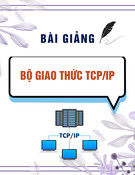

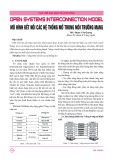
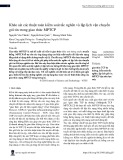


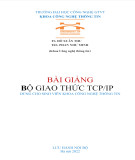
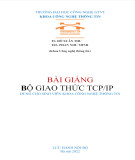
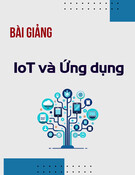






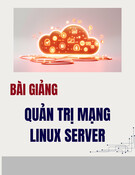
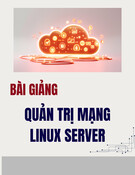
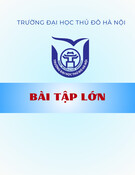
![Đề thi cuối kì Nhập môn Mạng máy tính: Tổng hợp [Năm]](https://cdn.tailieu.vn/images/document/thumbnail/2025/20251110/nminhthoi53@gmail.com/135x160/38281762757217.jpg)


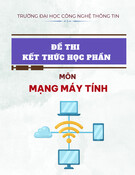
![Đề thi học kì 2 môn Nhập môn Mạng máy tính [kèm đáp án]](https://cdn.tailieu.vn/images/document/thumbnail/2025/20251014/lakim0906/135x160/23811760416180.jpg)
